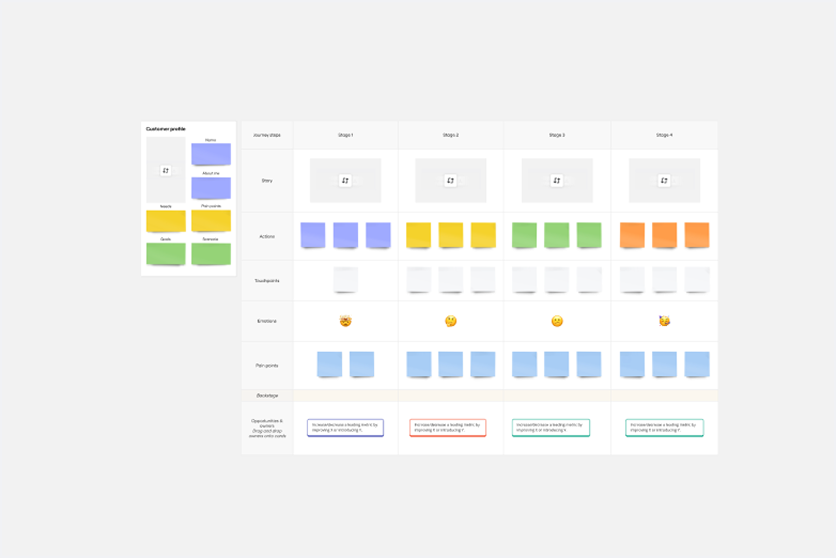Daily Stand-up templates
16 templates
The Daily Standup Template
141 likes
1K uses
Daily Standups
78 likes
909 uses
Painless + Effective Remote Standups
65 likes
282 uses
Visual Standup
31 likes
160 uses
Team Standup
7 likes
32 uses
Daily Stand-up Meeting Template
1 likes
28 uses

Daily Stand-up Meeting Template
The entire team meets to review the day before and discuss the day ahead. These daily meetings, also known as “scrums,” are brief but powerful — they identify roadblocks, give each team member a voice, foster collaboration, keep progress on track, and ultimately keep teams working together effectively. This template makes it so easy for you to plan daily standups for your sprint team. It all starts with picking a date and time, creating an agenda, and sticking with the same format throughout the sprint.
Task Master: Daily Standup Tracker
3 likes
21 uses
Experiment Standup Wall
9 likes
16 uses
4D Standup
5 likes
13 uses
Meeting Action Items Template
0 likes
12 uses

Meeting Action Items Template
Ever walked out of a productive meeting only to watch great ideas disappear into the void? The Meeting Action Items template helps you capture decisions, assign clear ownership, and track progress—all in one visual workspace. Built with Miro Tables, this template turns your post-meeting chaos into organized accountability that actually drives results.
Daily Stand-up Meeting Template
0 likes
7 uses

Daily Stand-up Meeting Template
The entire team meets to review the day before and discuss the day ahead. These daily meetings, also known as “scrums,” are brief but powerful — they identify roadblocks, give each team member a voice, foster collaboration, keep progress on track, and ultimately keep teams working together effectively. This template makes it so easy for you to plan daily standups for your sprint team. It all starts with picking a date and time, creating an agenda, and sticking with the same format throughout the sprint.

Explore more
About the Daily Stand-up Templates Collection
Miro's daily standup templates streamline your team's daily check-ins, ensuring everyone stays aligned and productive. These templates are perfect for agile teams looking to maintain a consistent and efficient routine. Whether you're conducting a scrum daily standup meeting or a general team check-in, our templates are fully customizable to fit your needs. With Miro, you can easily adapt the templates to suit your team's workflow, making every standup meeting more effective and engaging.
Why you'll love our daily standup examples
Daily standup meetings are a cornerstone of Agile practices, and using Miro's daily standup templates can significantly improve their effectiveness. Here are some detailed benefits:
Consistency and structure: Our daily standup examples provide a consistent framework for your meetings, ensuring that every standup follows a structured format. This helps in maintaining focus and making the most out of the limited time.
Improved collaboration: With Miro's collaborative features, team members can easily share updates, identify blockers, and discuss solutions in real time, even if they are working remotely.
Time efficiency: The daily scrum template is designed to keep meetings short and to the point, typically around 15 minutes. This ensures that the team can quickly align on priorities without wasting valuable time.
Visual clarity: Miro's visual tools allow you to create engaging and clear representations of tasks, progress, and blockers. This visual clarity helps in better understanding and quicker decision-making.
Editable and customizable: The templates are fully editable, allowing you to tailor them to your specific needs. You can add or remove sections, change the layout, and incorporate your team's unique processes.
Integration with Agile tools: Miro's templates can be integrated with other Agile tools like Jira, making it easier to sync tasks and updates across platforms.
How to create your daily stand-up meeting schedule
1. Set a time and place
Poll your team to learn whether they prefer morning stand-ups or end-of-day meetings. Daily stand-ups should become a useful part of everyone’s routine, setting the stage for their day or wrapping it up at the end.
2. Create an agenda
Daily stand-up meetings should not run any longer than it takes someone to start fidgeting while standing up! In general, aim for ten or fifteen minutes. To stay on task, create a quick agenda for standup meetings, one that sketches out what you hope to accomplish.
3. Stick to the same format
Once you’ve nailed down your time and place, come up with some questions that you hope to answer during each meeting. Many daily stand-ups aim to answer the following three questions: What have I accomplished since our last stand-up? What do I hope to accomplish before the next one? What obstacles might keep me from doing so?
Tip: You can also import Jira cards to track issues to keep team rituals focused.
How to use the daily standup templates in Miro
Using Miro's daily standup templates is straightforward and can be broken down into a few simple steps:
Select a template: Start by choosing a daily standup template. You can find templates specifically designed for scrum daily standup meetings, agile daily standup, and more.
Customize the template: Once you've selected a template, customize it to fit your team's needs. Add sections for high-priority tasks, blockers, and any other relevant information.
Invite team members: Share the template with your team members. Miro's collaborative platform allows everyone to access and edit the template in real time.
Conduct the standup: During the meeting, each team member can update their status directly on the template. This ensures that everyone is on the same page and can see the progress and blockers at a glance.
Follow-up: After the standup, use the team standup template to track any follow-up actions or discussions. This helps in maintaining continuity and ensuring that any issues raised are addressed promptly.
Daily stand-up meeting templates FAQs
What happens during a daily standup?
The daily standup meeting should last no more than 15 minutes. Each team member should answer three questions during the stand-up: What did you do yesterday? What will you work on today? Do you have any obstacles?
How do I organize my daily stand-up?
You can gather your high-priority tasks and share them with your team. Do mention if you have any problems or blockers completing them. If you want, you can take notes about other projects that might affect you or simply consult the daily stand-up meeting template later on. As this is a daily review practice, make sure not to spend too much time preparing for this meeting. The standup meeting format is supposed to be dynamic and just a regular check-in for teams.
What does a good standup meeting look like in practice?
A good standup meeting is short (15 minutes or less), starts on time, sticks to the three key questions, promotes active listening and interaction, ensures transparency, and is facilitated to keep the focus. If in doubt, check one of our daily check-in templates to run your remote team standup.
What are common problems with daily standups?
Common problems with daily standups include exceeding the allocated time, lack of preparation from team members, irregular attendance, passive participation, and the meeting unintentionally evolving into a full-fledged discussion or problem-solving session. To avoid that, make sure everyone is on the same page, facilitate the meeting to keep the focus, and promote transparency so everyone sees the value in the meeting.
How are standups different from other meetings?
Standups differ from other meetings in their frequency (daily), duration (short), purpose (syncing up the team and identifying blockers), format (three-question format), and attendance (mostly the executing team).
What questions should I ask in a standup meeting?
Successful standup meetings rely on asking the right questions and concentrating on progress, obstacles, and teamwork. For team progress tracking, ask: "What did you accomplish yesterday/since the last standup?", "What are you working on today?", and "What are your top priorities?" To uncover roadblocks, ask: "What obstacles are you facing?", "Is anything blocking your progress?", and "Do you need any help from the team?" Finally, for collaboration, ask: "Is there anything you need from other team members?", "Are there any dependencies that might impact others?", and "Do you see any potential roadblocks for the team?" These questions help the team stay aligned, identify issues quickly, and foster a problem-solving environment.
Remember to keep standups concise, focusing on action and moving detailed discussions offline. Encourage team members to be brief and to the point. Optional questions like "What are your learnings?" or "How can we improve our process?" can be helpful depending on your team's needs. By asking the right questions, your standups will be productive, efficient, and contribute to a successful sprint and your Agile workflow optimization.








